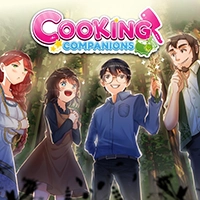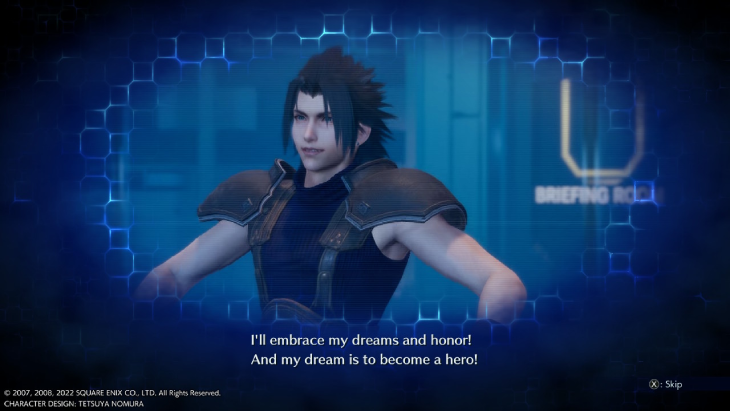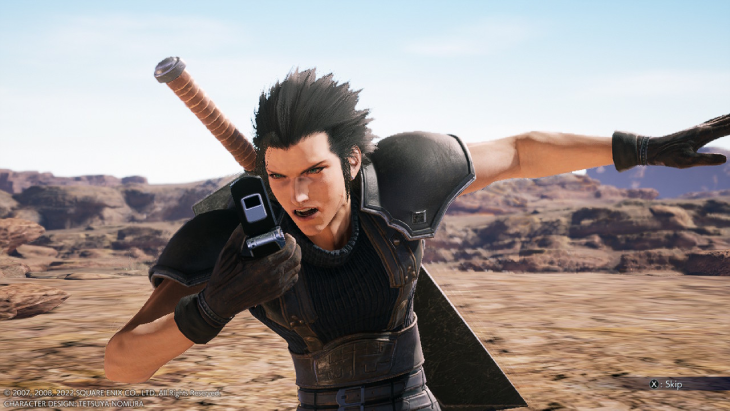
Nintendo has had a rough relationship with third party publishers over the years, and few games are as emblematic of this as Final Fantasy VII. Square Soft left the big N for the PlayStation when their ambition grew more powerful than the Nintendo 64’s cartridges. Today, the situation has improved, but not entirely. While Cloud and Sephiroth have joined Smash Bros, and the original game is now playable on the Switch, the ambitious FFVII remake trilogy seems too strong for Nintendo’s newest handheld. Luckily for us, its prequel did make its way to the Switch as Crisis Core: Final Fantasy VII Reunion. Let’s check out if this is a beautiful reunion or not.
Crisis Core: Final Fantasy VII Reunion is the prequel to the legendary Final Fantasy VII, featuring the origin story of many beloved characters and starring an original protagonist. You don’t need to have played the original game or its remake to fully enjoy Crisis Core. Granted, the prequel might spoil some big twists, but it won’t ruin the overall experience.
Our protagonist Zack Fair is a young, promising member of SOLDIER, an elite group of warriors fighting for the Shinra corporation. Aspiring to become a true hero, he follows the company’s directive without fault, a dedication that is destined to fall apart. As members of SOLDIER continue to disappear and desert, Zack is caught in the midst of a battle between Shinra, rebels, and the ex-SOLDIER Genesis. Throughout this journey, he will meet many colorful characters on his journey to find the truth about the SOLDIER program, and about what the difference between a human and a monster is.
Even without having played the original game, Crisis Core still tells an engaging story. Final Fantasy VII was a phenomenal success, so even newcomers will be able to recognize characters like Aerith and Sephiroth, but it does feel like it relies on this in some moments. Zack is an interesting character to follow, growing from a lovable idiot to a determined yet joyful hero. The posited themes are also fascinating, and the scene with him is undoubtedly the game’s highlight. However, the game does slog at points and the way Cloud was handled after that moment feels a bit jarring. Despite this, Zack’s story is an enjoyable one to play through and sets up the full game well.
Crisis Core: Final Fantasy VII Reunion is an action RPG adventure that takes you to Midgard and beyond. You have some areas you can return to, but most of the action takes place in linear levels, leaving little room for exploration. The recurring areas, like the slums or the Shinra building, do not feature skip travel, which feels jarring in one particular segment of the game. Luckily, the gameplay’s strength lies in its battles.
At any point when walking through enemy territory, an enemy can ambush you and start a battle. Yes, this game features random encounters. Seeing such an outdated feature in an action game feels weird. Zack’s combat is pretty basic: he’s got an attack, block, dodge, the usual. Additionally, you can equip “materia” to cast special attacks. These range from heals and elemental magic, which consume MP, and abilities, which consume SP. The latter are even enhanced when used during your normal attack string. Items are also always accessible, allowing you to quickly and easily recover from a setback. Movement can feel rigid though, as dodging and blocking don’t feel as smooth and responsive as similar games. Lastly, as this system is quite simple, the battles do get repetitive quickly. Materia doesn’t really help spice it up.
The enemy variety is no saving grace either. Visually, you do get to battle a varied rogues gallery, but gameplay-wise they do not stand out much. Most of them use basic RPG attacks, and while you will be able to recognize their moves, you likely won’t be remembering them. Luckily, the bosses fare a bit better in this department. The summons in particular are a spectacle, and the story bosses aren’t too shabby either, especially him.
There are some moments in the story mode with alternative gameplay, like parrying an onslaught of missiles, but those sections feel gimmicky and do not add much to the experience.
The Digital Mind Wave, or DMW for short, is most likely the weirdest game mechanic I have ever seen. It’s essentially a slot machine that is constantly rolling while you fight, trying to match both pictures and numbers. If you get a certain number combination, you get a buff depending on the code. These buffs range from a stat boost, to temporarily unlimited spell usage, and even a level-up if you get a triple 7. If the pictures align, you can channel the power of friendship (literally), and use the memories of your friends to use a powerful Limit Break. The DMW can also enter different states depending on your combat ability. The higher it is, the more the DMW will spin.

To channel the power of friendship, you’ll even occasionally recount some memories in combat to achieve a Limit Break. Strangely enough, they don’t interrupt combat.
The DMW sure is an interesting mechanic. On the one hand, it bakes an RNG element in every battle, keeping you on your toes. On the other, it often encourages a reactive play style, which isn’t the most interesting. The different states also mean that in some fights, you’ll barely have Limit Breaks, but in others, you’ll be spamming them. Yes, playing around the DMW can be fun and can be interesting to react to, but its inherent unreliability is why I hesitate to call this a “great” mechanic. To give it some credit, the DMW gets some great meta-use in the finale.

Using Tseng’s Limit Break to call in air support is pretty satisfying when you get the chance. It even works in buildings and caves!
You can take a break from the story by visiting a save point to tackle a Mission. These can be unlocked by playing through the story, talking to NPC’s, through in-game mail, or completing other Missions. They are essentially short levels with a few enemies for you to defeat, with some treasure chests to loot. They grant you many different items as rewards, even some for completing a set percentage of all missions. Some missions even grant you the ability to add summons to your DMW. They range from gods to giant chickens — they’re great.
The missions themselves aren’t really exciting though. For the most part, they’re just battles. Some do have an interesting plot, like one featuring another recognizable character, but I never felt drawn in by them. They do not add as much variety as they should.
Improved models and revamped music were two of the biggest selling points for this remake, and they do deliver. While the soundtrack was not incredibly memorable to me, the tunes are great to listen to. Visually, the game looks great as well. The character designs look great, the environments are varied throughout and the UI is a pleasure to look at. though some of the pre-rendered cutscenes did look a bit blurry on the Switch. Lastly, the game runs smoothly in general, but I wasn’t spared from the occasional glitch. For instance, the battle theme suddenly disappeared for me while fighting the final boss, which did ruin some immersion for me.
While the Final Fantasy VII Remake itself isn’t headed for the Switch, we have been blessed by its prequel’s remake. Crisis Core: Final Fantasy VII Reunion makes for a great set-up for the main game, while still standing proud as a great standalone story. Zack and his friends are bound to keep you entertained on this epic journey. Despite that, battling might start feeling like a slog when you approach the finale. Its central combat mechanic, the DMW, feels both unreliable and engaging at the same time. Safe for the rare story moment, all you will really do is run around and fight. Despite that, this is a definite must-play for Final Fantasy fans, and any RPG fan should consider giving it a look.
Crisis Core: Final Fantasy VII Reunion gets a 7.5/10.